50s and 60s radio
At the beginning of the fifties, radio in Britain consisted of just three BBC stations, the Light Programme, the Home Service and the Third Programme. The Light Programme broadcast light entertainment and some popular (though rarely pop) music. The long-running series, "Dick Barton - Special Agent" was broadcast on the Light Programme. The Home Service was a mixture of news and entertainment - a favourite was 'Saturday Night Theatre'. The Third Programme was dedicated to "serious" drama and classical music - it was the least popular of the three. If you wanted to hear pop music, then Radio Luxemburg was the place to tune the dial to in the fifties. In the sixties, it was pirate radio until 1967 when the BBC broadcast Radio 1 for the first time.
Radio sets in the fifties and sixties varied from large valve models to the smallest transistor sets. As the fifties began, all radio sets used valves. Portable sets of the era needed some hefty batteries - up to 90v. There were generally two types - a box that was turned on by opening the lid, and a handbag style with a carrying handle. One of my favourites is the Bush MB60 from around 1957. The styling of this set is very much of the era.
Valve radios
Bush MB60
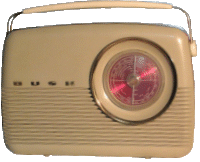
The Bush MB60 used five thermionic valves. It could pick up medium wave and long wave, which was fine in 1957. It could run off battery or mains. Bush produced an all transistor version of this set in the sixties. There are even some versions with the FM band - it was always called VHF in those days.
This particular set belonged to an aunt and uncle of mine. It was in use well into the seventies.
Ekco console radio
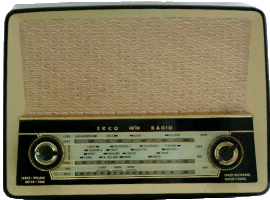
As well as portable sets, there were table top, or console style valve radios. These were not meant to be carried around. In the thirties, the radio was often the focus of attention in the house. Families gathered together to listen to their favourite programmes. Its place in the fifties was somewhat displaced by the television, but the console set remained popular.
This radio, by Ekco, is typical of the style. It can pick up long wave, medium wave and VHF.
Transistor radios
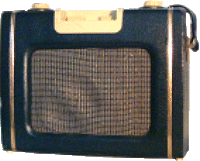
The first all-transistor radio was the "Regency TR-1" produced by Texas Instruments in the US. It was in the shops in America in time for Christmas 1954. The first all-transistor sets produced in Britain were very similar to their valve predecessors. They tended to be quite large - about a foot high. The "Every Ready Sky Leader", c1957 (right) is no exception. It cost £22 4s and 6d in 1957.
It was the Japanese who really exploited the possibilities of the transistor for miniaturisation. Although the first shirt pocket radio was American, the Japanese were not far behind, with the most well-known brand being Sony. Names, now associated with much more technologically advanced products today, first appeared on small transistor radios in the sixties. Toshiba, Hitachi, Sanyo, Sharp and NEC all made pocket transistor radios in the sixties. It was left to a British firm though, to take miniaturisation to its ultimate extreme. The smallest radio of the era was the Sinclair Microtronic - less than 2" high - it could only power an earphone.
The 1960s was really the era of the pocket transistor set. Like the Sony Walkman and ghetto blasters of later years, they allowed young people to listed to the latest pop music on the move. The Beatles and the Rolling Stones would have been heard in rather "tinny" tones coming out of pocket radios throughout the sixties.

In spite of their undoubted success, pocket radios of the sixties were not known for their quality or reliability. A 'Which?' report produced in 1966 found that many pocket radios failed to work when taken home from the shop. Many others developed faults very quickly. A huge variety of brands were available. Many Japanese, but some well known names in the British radio industry also produced pocket radios. This "Pye", although a British name, was "Empire Made" - more than likely made in Hong Kong.
Cassette tape
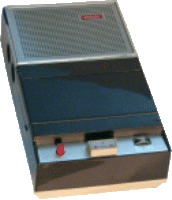
A new invention for the sixties was cassette tape. In 1963 "Philips" launched the world's first cassette tape recorder - the EL3300. Prior to that, tape recordings were made on much larger reel to reel machines.
Radiograms
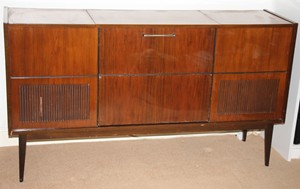
One of the most popular consumer goods bought for the home in the fifties and sixties was the stereo radiogram. This was a record player and radio combined. They often came in beautifully finished wooden cabinets designed to fit in with domestic furniture. Most were modern in style - reflecting the look of other consumables from the era. When closed, they resembled a trendy sideboard. However, they could be encased in reproduction antique cabinets as well. Dynatron produced a variety of period styles including 'Queen Anne' and 'Regency'.
Tips on collecting radios
Visit the National Vintage Communications Fair held at the NEC twice a year - usually April or May and September or October. There are more radios and gramophones for sale under one roof than anywhere else I have seen. You will be able to look compare prices between the various dealers and get a bargain.
When you by an old radio you have to satisfy yourself as to its electrical safety. A set bought from a reputable dealer and sold as restored can be expected to be in full working order and safe. Sets bought from more general antique dealers can often be as expensive and may have had no electrical testing carried out on them whatsoever. Sometimes sets turn up in junk shops - they can be a bargain - but more often than not the proprietor will have inflated the price based on the idea that old radios are "collectible" and values given in Miller's Guide for fully restored sets - close examination of these sets usually shows damage making them worth only a fraction of the asking price. You need to look carefully for cracks in Bakelite and plastic sets. These affect value significantly. Missing or damaged parts can also be difficult to find or replace.
More on vintage radio:
On the Air
A museum based in Chester devoted to vintage radios and gramophones.
www.vintageradio.co.ukVintage radio
A superb site about vintage radio. It is packed with information and hosts discussion groups about all aspects of radio collecting and restoring.

